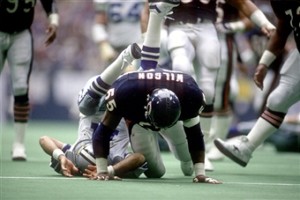Sports Injury Treatment Then And Now
 The ancient Greek philosopher Heraclitus probably first said that “the only constant in the universe is change.” This phrase definitely applies to sports injuries, at least to some extent.
The ancient Greek philosopher Heraclitus probably first said that “the only constant in the universe is change.” This phrase definitely applies to sports injuries, at least to some extent.
Some people still remember the 1992 NBA All-Star game which featured the return of Magic Johnson. A few months earlier, he had retired after announcing he was HIV positive. Several other players, including Karl Malone, openly expressed misgivings about Johnson’s return and their own risk of contracting AIDS. We now know these fears were foolish, but they were very real at the time.
Fortunately, deadly sexually-transmitted diseases like AIDS are not a problem on most sports teams. But sports injuries are a constant concern. In some cases, the treatment approach has changed significantly in recent years; in other cases, not so much.
Football and Concussions
Head injuries have been an issue in football ever since William Harvey laced up the cleats for Penn in 1894. “In a scrimmage behind the goal I was knocked insensible, but recovered in about fifteen minutes,” he later wrote. For the next hundred years, every player who received a head injury in football got basically the same treatment: a few plays off, some smelling salts, and a cursory “how many fingers am I holding up” medical exam.
Things began to change in 1994 when then-NFL Commissioner Paul Tagliabue ordered league doctors and other scientists to examine the problem more closely. Today, no one is really sure how the NFL and other football leagues should handle head injuries. Players want to play, coaches want to win, and fans want to see lots of action, but a player’s long-term health is at stake. There’s a balance there somewhere.
New innovations should help improve treatment protocols. For example, the Food and Drug Administration recently approved a concussion diagnosis blood test. Very soon, this test could eliminate the guesswork involved in this area.
All Sports and Ice
To ice or not to ice. That is the question, and for a long time, no one really knew the answer. Ice decreases inflammation and relieves pain, and those could be good things or bad things. Inflammation is a natural element in the body’s healing process, and pain lets the athlete know that something is wrong.
So, many people hedged their bets. Baseball pitching coaches often packed shoulders in ice as soon as the starters came out of the game and then sternly warned these players not to sleep too close to a window air conditioner in the hotel room.
Current consensus is that long-term icing is probably a bad thing. However, it’s essential during the first 48 post-injury hours. It’s also a bad idea to just hold a few ice cubes over the injured body part. Instead, use a specially-designed ice pack or wrap that spreads the cold over a larger area.
Football and Pre-Game Stretching
Most of us have seen images like this one of football players stretching together before a game. The Dallas Cowboy in this picture (Drew Bledsoe) could have easily been one of the other number 11s in a Dallas uniform, such as 1980s quarterback Danny White or 2010s slot receiver Cole Beasley.
Back in Danny White’s day, almost everyone agreed that pre-game stretching was a good idea. In Cole Beasley’s day, almost everyone agrees that stretching after the game or fitness run, while the body is warm, is the best approach. In fact, intense pre-activity stretching could cause a fitness injury, like a pulled muscle.
But sometimes, word travels slowly. Cole Beasley and any future Dallas number 11 will probably be on the field for mandatory pre-game stretches because this time also promotes team building and some other positive things.
The lesson here is that before you begin treating your sports injury, do a little homework to make sure your approach is the right one.
cincinnati reds fitted hat larger quarter,los angeles dodgers batting practice hat zionsville,new york yankees pin fitted hat larger,chicago white sox 1917 hat jobs
adidas tubular material http://www.chaddhuffman.com/adidas-tubular-materi…